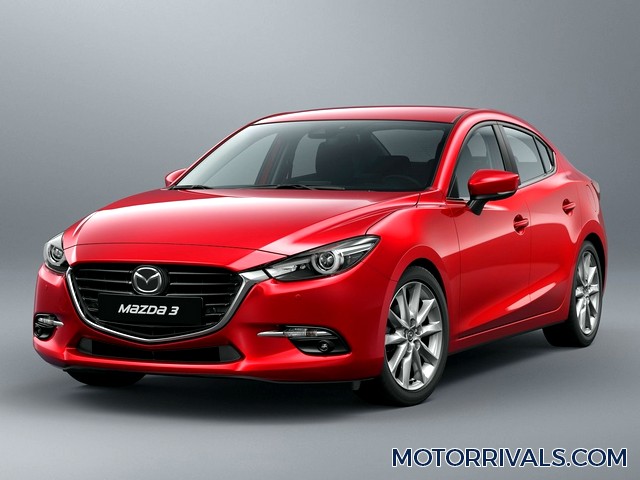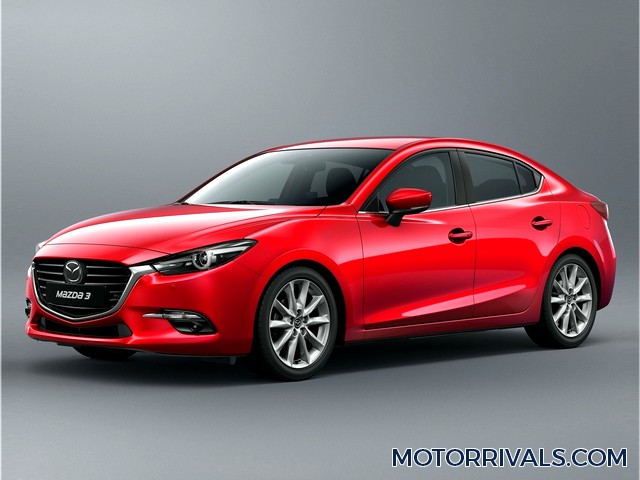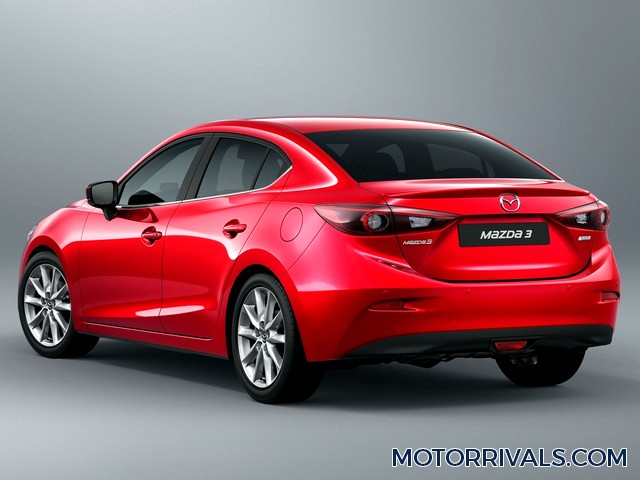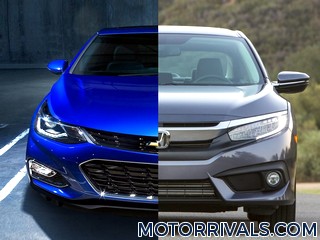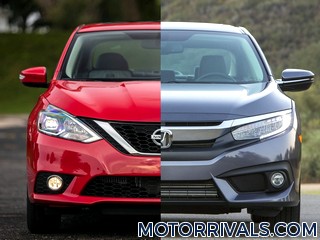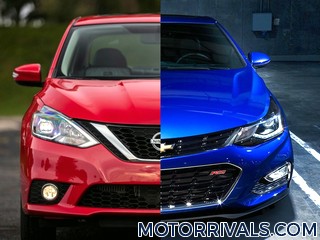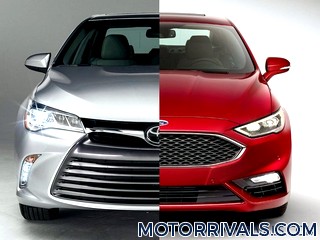2017 Mazda 3 vs 2017 Nissan Sentra
Mazda Press Release Highlights
Building on its award-winning predecessor, developers of the all-new Mazda 3 set out to do no less than come up with a car that actually interacts with its owner on several levels. On the surface, it's a top quality means of transport, delivering an unmatched combination of performance, fuel efficiency and functionality in a package that's as safe and practical as it is stunning. Here it follows in the footprints of its new generation forerunners: the Mazda CX-5, a compact SUV that drives like a car, and the new Mazda 6, which more recently took the mid-sized class by storm.
Powertrain
The new Mazda 3 also comes with the SKYACTIV-G 2.0 in two versions. The high-power version churns out 121kW / 165PS at 6,000rpm and 210Nm at 4,000rpm. It thrusts the compact from a standstill to 100km/h in 8.2 seconds with a terminal speed of 210km/h. At 5.8l/100km and 135g/km, fuel consumption and CO2 emissions are very respectable for such performance. The standard power SKYACTIV-G 2.0, meanwhile, puts out 88kW / 120PS at 6,000rpm and, like its sibling, 210Nm at 4,000rpm. Available for both body styles with either the SKYACTIV-Drive automatic or SKYACTIV-MT manual transmission, this economical option combines first-rate fuel efficiency and CO2 emissions - 5.1l/100 km and 119g/km (manual) and 5.6l/100 km and 128g/km (automatic) - with respective sprint times of 8.8 and 10.3 seconds, topping out at 198km/h.The SKYACTIV-D clean diesel also uses extreme compression and lightweight design as the basis for powerful yet remarkably fuel-efficient engines. Unusually for a diesel, the 380Nm of maximum torque at 1,800rpm and 110kW / 150PS at 4,500rpm offers satisfying pull from a standstill through to its 5,500rpm redline. The new Mazda 3 takes only 8.0 seconds to reach 100km/h with a manual and 9.7 seconds for the automatic (hatchback only), with respective top speeds of 213km/h and 201km/h. And that with fuel economy and CO2 emissions of 3.9l/100km and 104g/km (sedan with manual), and 4.8l/100 km and 127g/km (hatchback with automatic).
Chassis
Mazda tuned the new Mazda 3's SKYACTIV-Chassis to respond more faithfully than ever to driver intentions. High-tensile steel (780MPa) was used for the lower suspension arms on the front MacPherson struts and rear multi-link trailing arms. This not only makes the suspension lighter, but also smoothens load transfers and with it changes in cornering g-forces. The positioning of rear suspension links and hardness of the bushings, meanwhile, improves the lateral grip of the rear tires. By moving the trailing arm position forward, the dampers can better absorb road influences.The electric power assist steering's lower gear ratio - 14:1 versus 16.2:1 on the current model - means less steering wheel movement, enhancing agility and helping avoid driver fatigue, particularly on winding roads and in the city. The system is smaller, lighter and more energy efficient, too. The brakes get smaller cylinders, retuned boosters and reduced pedal play to suppress motion resistance. These improve brake control, responsiveness and fuel economy. In combination with new high-grip tires, they're particularly effective on wet roads: Stopping distances are considerably shorter than the current model and among the best in the segment.
Technology
The in-vehicle system expands on features already available in Mazdas, like Bluetooth®, email, SMS and navigation, adding a whole new scale of connected convenience. Using a smartphone connected to the Mazda 3 system via Bluetooth® or USB, Mazda 3 occupants have safe and easy real-time access via the 7-inch display to infotainment services from Aha. It offers a wide and growing range of mobile infotainment content and social media services, including tens of thousands of internet radio stations, Twitter and Facebook feeds, news, audio books and more.Aha is a cloud-based automotive grade internet connectivity platform. Available for the first time at Mazda with the all-new Mazda 3, Aha is designed to provide a single integration point bringing a wide range of free web-based infotainment content safely into the vehicle. Aha lets the user access and organize their favorite web content on their phone, then seamlessly integrates the experience in their car. Developed together with BOSE® especially for the new Mazda 3, the new 9-speaker BOSE® premium sound system features the latest in playback technology and, of course, plenty of power.
Safety
i-ACTIVSENSE is Mazda's term for its advanced range of sensor-based and radar-supported safety technology. The radar-based Rear Vehicle Monitoring system (RVM), for example, tells the driver when vehicles are approaching the new Mazda 3 from behind in adjacent lanes - including the blind spots - by activating an LED in the corresponding side mirror. The Lane Departure Warning System (LDWS), meanwhile, watches the lane markings at 65km/h and higher, alerting the driver with audible (rumble strip sound) and visual warnings should it detect unplanned lane changes. And the Distance Recognition Support System (DRSS) looks well ahead of the car, calculating and displaying the proximity and catch-up time to preceding vehicles at 30-200km/h. The Adaptive Front-lighting System (AFS) predicts the shape of the curve ahead based on steering input and speed, turning the headlamps in the right direction. Hill Launch Assist (HLA) is another helpful system that maintains brake pressure to prevent rolling during hill starts. i-ACTIVSENSE pre-crash safety technology warn the driver of potential danger. However, as names like Mazda Radar Cruise Control (MRCC) and Smart Brake Support (SBS) suggest, they'll also take evasive action if necessary to avoid an accident or limit the damage. Naturally, the new Mazda 3 also has standard ABS with electronic brakeforce distribution (EBD) and brake assist (EBA) as well as dynamic stability control (DSC) and traction control (TCS).Nissan Press Release Highlights
Key features of the Sentra exterior include a new front fascia, grille, fenders, hood and signature boomerang-shaped headlights. New LED low-beam headlights with LED signature accents are offered on Sentra SR and Sentra SL grades. In the rear, a new fascia with redesigned boomerang-shaped taillights adds a more premium appearance. As in previous years, Sentra's exterior design is elegant, modern and refined, reflecting a "professional" character targeted at upwardly bound buyers who aspire to drive something more upscale than other designs in the segment. Exterior features include chrome door handles and chrome window accents and available heated outside mirrors with integrated turn signals. The new Nissan Sentra SR Turbo is expected to help keep the sales momentum going by expanding its market reach. In addition to the new SR Turbo (6MT and Xtronic), the 2017 Nissan Sentra is offered in four other grade levels: Sentra S, SV, SR and SL (Xtronic).
Powertrain
At the heart of the SR Turbo is its new 1.6-liter Direct Injection Gasoline (DIGTM) turbocharged engine that delivers a 50 percent horsepower increase from the normally aspirated 1.8-liter Sentra SR powerplant. Rated at 188 horsepower and 177 lb-ft of torque, the new SR Turbo engine offers 64 more horsepower and 52 more lb-ft of torque than non-turbo 2017 Sentra grades.All 2016 Sentra models utilize a fuel-efficient 1.8-liter 4-cylinder engine mated to an advanced Xtronic transmission with sub-planetary gear. A 6-speed manual transmission is also available with the Sentra S grade. The advanced 1.8-liter DOHC 4-cyinder engine offers a longer stroke than typical engines in its class, resulting in improved combustion speed and efficiency. The engine is equipped with a twin Continuously Variable Timing Control (CVTC) system which modulates both the intake and exhaust valve opening time. The engine is rated at 130 horsepower and 128 lb-ft of torque.
The Xtronic transmission offers a wide gear ratio range of 7.3:1 through use of a sub-planetary gear and smaller pulleys, resulting in high-speed fuel efficiency and responsive acceleration. The Xtronic's acceleration feel is enhanced with a D-mode step shift program that simulates shifts, giving a more natural acceleration feeling without holding a high rpm constant, letting rpms build as speed builds. For 2016, the D-Step Logic Control has been revised to help provide enhanced drivability with a more stable, natural and crisper shift feel (versus the previous design).
To help handle the increased power and torque, the new Sentra SR Turbo also receives an enhanced body structure, revised steering system, larger front disc brakes, new 6-speed manual or Xtronic transmission with manual mode and unique suspension tuning.
Chassis
The 2016 Sentra also delivers enhanced performance and handling through a retuned suspension design featuring a 10 percent increase in spring and damper rates (from the prior model year), as well as enhanced body stiffness for improved roll and body control through adoption of a new front tunnel stay similar to that used on the JUKE NISMO RS. The Sentra suspension features an independent strut front layout with stabilizer bar, torsion beam rear axle with integrated stabilizer bar.Steering feel and response has also been improved through use of optimized Electric Power Steering (EPS) mapping in conjunction with the revised suspension and new tire design. A power-assisted vented front disc/rear drum braking system (4-wheel disc brakes are available) is standard along with retuned vehicle-speed-sensitive electric power steering.
Technology
The 2017 Sentra SR Turbo includes a standard power sliding glass moonroof and SR Turbo badging. The SR Turbo Premium Package, the only option package available with the SR Turbo, includes Blind Spot Warning (BSW), Rear Cross Traffic Alert (RCTA), leather-appointed seating and Bose® Premium audio system with eight speakers.The standard Sentra audio system is an AM/FM/CD system with four speakers and USB connection for iPod® and other compatible devices. Other available audio systems include a 6-speaker AM/FM/CD system with 5.0-inch color display. Also available is SiriusXM® Satellite Radio (SiriusXM® subscription required, sold separately), while Bluetooth® Hands-free Phone System is standard on all grades. The Sentra offers advanced technology features that help owners stay connected - including NissanConnect with Mobile Apps, which is standard on SV and SR grades and includes iHeartRadio, Pandora® and Facebook.
Safety
A number of Nissan's advanced Safety Shield Technologies are now available on Sentra for the first time for the 2016 model year - Forward Emergency Braking (FEB), Intelligent Cruise Control (ICC), Blind Spot Warning (BSW) and Rear Cross Traffic Alert (RCTA). Intelligent Cruise Control (ICC) and Forward Emergency Braking (FEB) are combined as part of the new Technology Package offered for Sentra SR and SL grades. Blind Spot Warning (BSW) and Rear Cross Traffic Alert (RCTA) are included in the Navigation Package (SV and SR grades) and are standard on Sentra SL.In addition, Sentra's list of standard safety and security features include the Nissan Advanced Air Bag System (AABS) with dual-stage supplemental front air bags with seat belt and occupant classification sensors; front seat-mounted side impact supplemental air bags; roof-mounted curtain side impact supplemental air bags with rollover sensor for front and rear-seat outboard occupant head protection; 3-point front and rear seatbelts, front seat belts with pre-tensioners and load limiters and adjustable upper anchors; and LATCH System (Lower Anchors and Tethers for CHildren).





